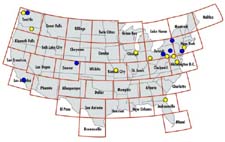For the very latest news and updates, visit AOPA Online.
| | GA News
|  FEDS LIFT VFR RESTRICTION WITH SOME CAVEATS FEDS LIFT VFR RESTRICTION WITH SOME CAVEATS
Late Wednesday, the FAA issued a notam authorizing the limited return of VFR flights under FAR Part 91. All civil flights were grounded in the wake of terrorist attacks on September 11; IFR flights resumed with restrictions on September 14 and those restrictions remain in effect. VFR is now permitted for U.S.-registered aircraft outside of "enhanced" Class B airspace—the outermost lateral limits of Class B airspace from the surface to infinity (see graphic). No VFR flights are permitted over the top of Class B airspace, nor are VFR operations permitted from airports and airspace "under the shelf" of Class B airspace.
Restoration of limited VFR flight followed an eight-day effort by AOPA staff that included numerous dialogues between AOPA President Phil Boyer and FAA Administrator Jane Garvey, Secretary of Transportation Norm Mineta, and members of Congress. The association submitted multiple proposals to get VFR back into the skies. Melissa Bailey, AOPA vice president of air traffic services, has been stationed at FAA headquarters to coordinate communications and help to remove additional remaining restrictions. Boyer summarized AOPA efforts to restore flying privileges as "a watershed moment in the association's proud 63-year history." Frequent updates on AOPA Online, the association's Web site, informed members, the GA industry, and even media representatives.
Boyer got the word about the lifting of most VFR flight restrictions during a Pilot Town Meeting in Columbus, Ohio, Wednesday evening. "This is a crucial step in restoring the nation's important general aviation system. Rest assured the effort isn't finished," he said. At AOPA ePilot deadline VFR flight training operations remain prohibited. AOPA is working to obtain a clear definition of what flight training activities are prohibited, as well as for the resumption of training flights. Restrictions continue to apply to banner towing, traffic watch/reporting, airships/blimps, and news reporting. See AOPA Online for the latest developments.
BAN LEAVES FLIGHT SCHOOLS REELING
While much of the country attempted a return to business as usual, flight schools and FBOs found it impossible to do so. As of Thursday afternoon, a continuing ban on VFR flight training left operators unable to conduct 90 to 100 percent of daily flights. Although business owners express grief and empathy for the victims, and understanding of last week's Part 91 flight restrictions, they struggle to comprehend why flight training remains prohibited. "We're being singled out because there is a link to flight training" in the attack, says Larry Ramsdell, owner and president of Aspen Flying Club, based at Centennial Airport in Englewood, Colorado. Among operators contacted by AOPA, losses average $1,000 to $6,000 in daily flight training revenues against fixed costs, such as insurance and rent payments, that continue to accrue regardless of activity. Many schools have laid off employees, and most foresee closing, at least temporarily, if restrictions continue through the end of September.
WHAT QUALIFIES AS FLIGHT TRAINING ACTIVITY?
AOPA is asking the FAA for a clear definition of what flight training activities are prohibited. AOPA members have already asked: Is a flight review for a certificated pilot (such as a BFR or instrument proficiency check) flight training? What about student cross-country solos? Touch-and-goes in the pattern by either a student or certificated pilot? AOPA will post the FAA's answers as soon as they are available on AOPA Online, and will make sure the flight service stations also know the official line from FAA headquarters.
AOPA WORKS TO FREE STRANDED AIRCRAFT
One of AOPA's top priorities, besides getting approval for the resumption of flight training activities, is to get relief for VFR pilots whose aircraft are trapped on the ground inside enhanced Class B airspace. AOPA's airports staff has determined that there are some 41,800 general aviation aircraft based on 282 airports inside the 30 enhanced Class B airspace areas. Those aircraft would normally account for some 21 million operations a year. There are also numerous transient aircraft trapped at these airports, unable to fly home VFR. AOPA discussed with FAA officials yesterday procedures for relocating aircraft grounded inside the Ronald Reagan Washington National (DCA) and John F. Kennedy International (JFK) temporary flight restriction (TFR) areas. The TFRs prohibit all Part 91 IFR and VFR general aviation flights within 25 nautical miles of the Washington, D.C., and New York JFK VORs.
 AIRSPACE RESTRICTIONS DOT SKY AIRSPACE RESTRICTIONS DOT SKY
You can’t rely on your GPS to keep you out of TFR areas. Even familiar restricted areas may have been expanded. For example, the prohibited area over the president's retreat at Camp David in Maryland is much bigger than it was before. Other TFRs have been placed over sporting events. AOPA is cautioning pilots to be careful so that flying rights are not further restricted. Click here for more information on the latest VFR and IFR restrictions and illustrations of TFR areas. It's also a good time to review intercept procedures should you find yourself in trouble with fighter aircraft. See AOPA Online.
PILOTS EXPRESS VIEWS TO AOPA
Using 50 randomly-placed "perception analyzer" interactive transmitters, Boyer polled a 400-plus member crowd at Wednesday's Pilot Town Meeting in Columbus, Ohio. Is GA a threat to national security? No, said 80 percent. Are increased security measures needed for general aviation? No, 60 percent. Do recent events raise concerns about the future of GA? Yes, 98 percent. Has AOPA acted appropriately? Yes, 96 percent. Are the majority of your flights under VFR? Yes, 92 percent. Do you support the establishment of temporary airspace restrictions when the government says there are risks or threats? Yes, 94 percent. Should flight training for international students be more strictly monitored? Yes, 86 percent. Should pilots have to submit to a background check to receive flight training and/or receive a pilot certificate? Yes, 46 percent. Do you support the establishment of a new pilot certificate with a photo ID and time limits after completion of a background check? Yes, 63 percent.
THE SEMINARS MUST GO ON, ASF SAYS
ASF safety seminars that had been scheduled prior to the terrorist attack continued this week. Presenters were provided with special information concerning IFR flight operations. Topics such as TFRs, the importance of notams, and what to do in the event of being intercepted by military or law enforcement aircraft were discussed. These topics will also be discussed at every weekend ASF Flight Instructor Refresher Clinic (FIRC). See AOPA Online.
| |

